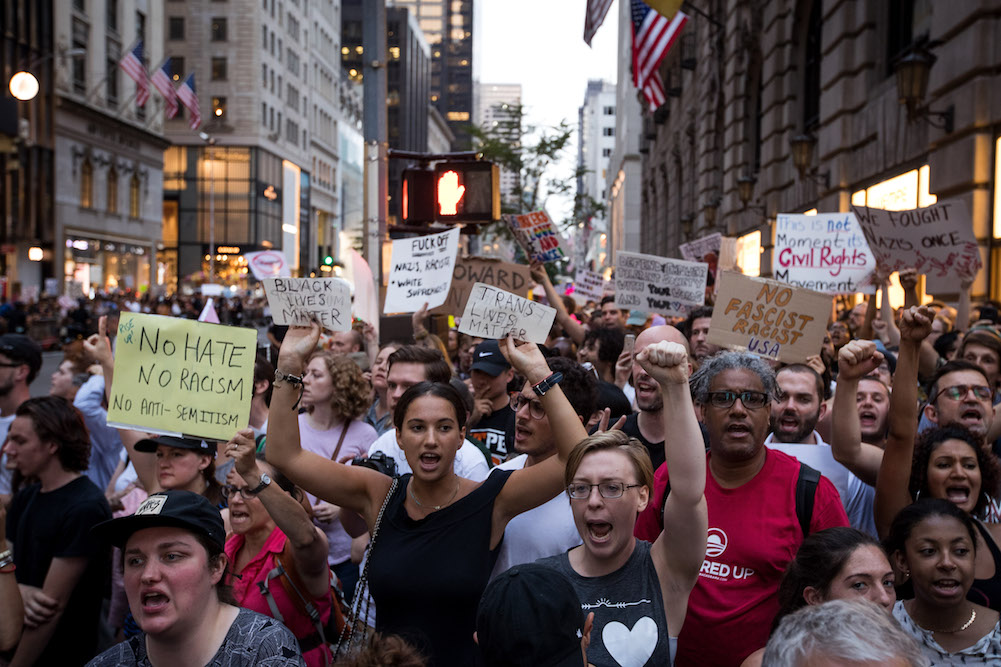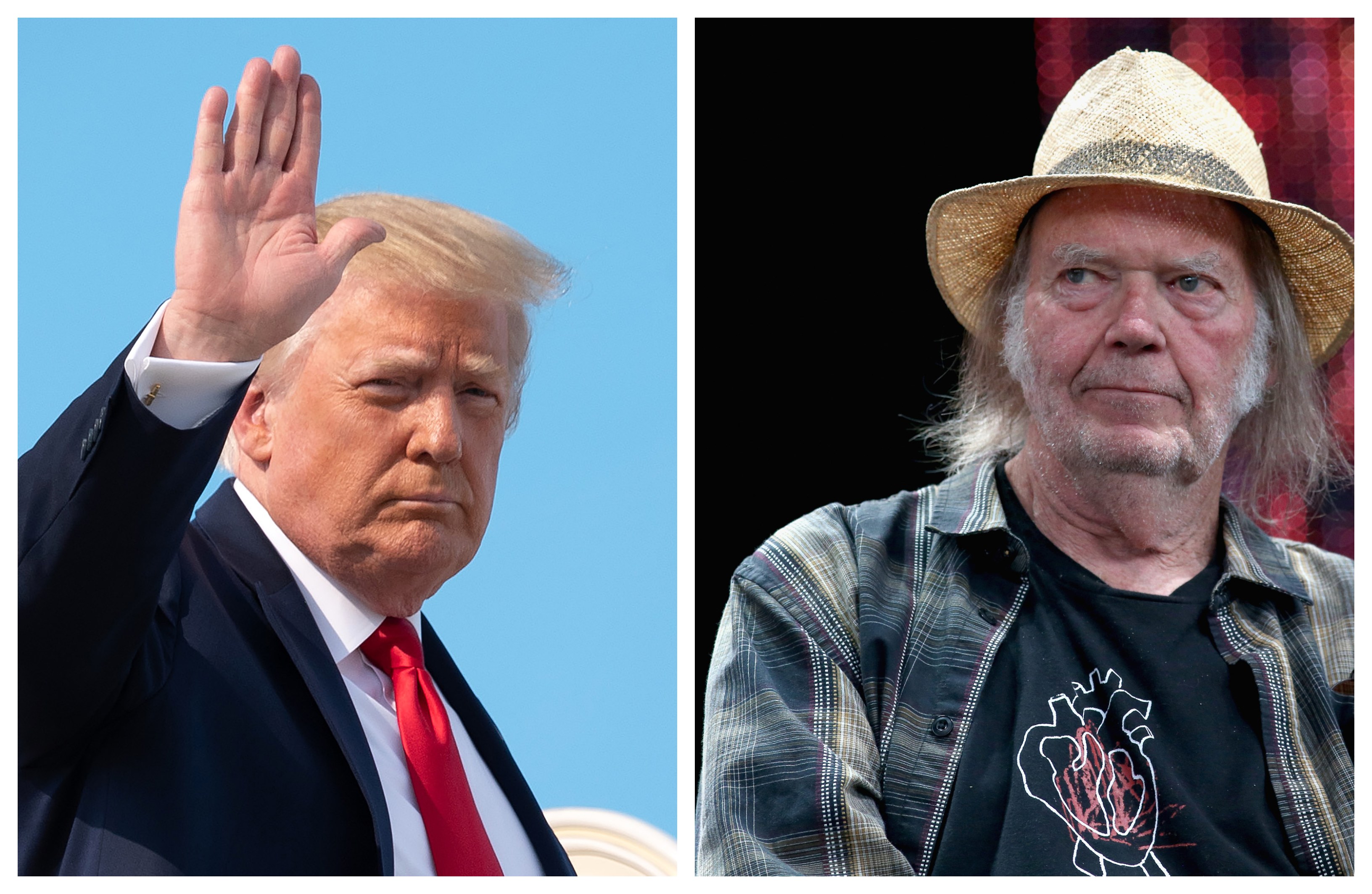Trump Tower was built with the help of undocumented immigrants, and is the centerpiece of brand kickstarted by a $1 million loan from Donald’s father Fred, whose arrest at a Ku Klux Klan rally remains an inextricable part of the family’s legacy. Over the past 12 months, the skyscraper has morphed from a symbol of gaudy decadence to an aloof throne for an autocratic ruler, in the heart of what’s supposed to be one of the country’s more progressive cities. On Monday, civilians gathered to rebuke what it represents.
The evening’s protests were pegged to Donald Trump’s return to the tower for his first time as president. They were also a display of solidarity with the weekend’s events in Charlottesville, where white nationalist protests boiled over into a city-wide conflict that killed 32-year-old counter-protester Heather Heyer. When I arrived, police were barricading the intersection at 5th Avenue and East 56th, clearing the sidewalk of the anti-fascism signs and raised fists congregating in the street.The front was guarded by dump trucks filled with sand, which a policeman told me worked well as “moving barriers” in case of an attack. In the northern corners, the hundreds of protesters were initially contained to the sidewalks before the guards relented and let them onto the street, behind the intersection and blocked off from the tower. Police on foot and atop horses flanked the crowd, loosely boxing them into a block-long rectangle. A helicopter hovered above.
Travis Morales, a 65 year-old volunteer for Resist Fascism, was giving a speech through his megaphone when he pointed out right-wing personality Laura Loomer in the crowd. Loomer, who recently interrupted Shakespeare in the Park’s performance of “Julius Caesar” to claim it promoted violence against the right, winked and smiled. In her hand she held a camcorder which was livestreaming the protest to her Twitter feed.
Another Jewish woman, a 26 year-old demonstrator named Katherine Kornman, was vocally upset by Loomer’s presence at a protest condemning alt-right ideologies. Nearby, after being taunted as “resembling a communist” by Loomer, a protester in an army green hat bearing the Cuban flag pressed forward to say something even more direct. Loomer’s Twitter followers commiserated with her over what was captured on her Periscope: “My god liberals are unhinged,” one concluded.
After the sun went down, I saw a twenty-something white man carrying alt-right personality Milo Yiannopolos’ book underneath his arm, the cover purposefully displayed as facing out. “You’re not fucking welcome here,” a woman shouted in his direction. She and a few others formed a wall to force him out from the mass of demonstrators. Enthused and defiant, the Milo fan readied himself to re-enter the crowd of protesters when a bespectacled, thin man confronted him.
“Go that way,” he motioned to a clear sidewalk that lead to 6th Avenue, “If you wanna get out.” “Well, I’m allowed to be here, so why can’t I assemble here just like ike you?” His scrawny figure barely filled out his black “HILLARY FOR TREASON” shirt.
“Because it’s a goddamn risk to your health. And you’re a fucking asshole.”
“And I appreciate that, thank you very much.”
“And you deserve all the pain that’s coming your way,” the frustrated samaritan said as he walked away toward the safe exit in a huff. The Yiannopoulos fan pushed his way into the crowd, was turned away once more, and eventually walked off, his face as smug as the book cover.
These tensions were mainly civil and kept on the sidewalks by design. Well before the protest and in its earlier hours, police had slowly been closing streets to create a radius of police vans, uniformed officials, and barricaded streets around Trump Tower. While the “Whose streets? Our streets!” rallying cry remained, the effect was noticeably different from when tax day, immigration ban, and Women’s March protests gathered. As protesters tried to make their way uptown via sidewalks, people in nearby buildings took photos and watched from the windows of the buildings that loomed above them. A young boy, dressed in a navy polo with his hair parted in a ready-for-prep fashion, nibbled on his finger behind excited spectators as he stood under the white glow of one of south Central Park’s many high-rise entrances.
This is, of course, the sort of mild curiosity that we can expect from onlookers now that the act of protesting feels more like instinctive civic duty than a rarity. When a sitting president could wait to do the bare minimum of denouncing Nazism and white supremacy, the people who openly do could unite against the absurdity of living through such a time. Signs that read “No Fascism,” “No hate, no fear,” and ones that pictured swastikas covered with the prohibition “no sign” were the most visible in large quantities, a surreal sight in 2017 midtown Manhattan. The symbolism was clear.
The procession made it back to 55th before 9 p.m., just in time to jeer Trump’s arrival. They chanted as the black and tinted motorcade eventually made its way through the street. They continued booing the passing vehicles, though nobody could see whether it was Trump himself. I asked a tall, bald-headed stranger, who was shouting along with the anti-Trump chants, if he knew why we were still there.
“Yeah.” He looked up and pointed. An orange light was visible from the Tower. “That’s his penthouse that’s lighted up.”





